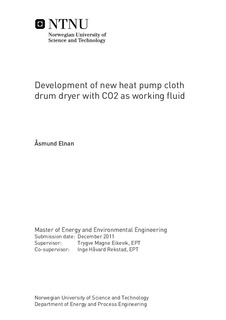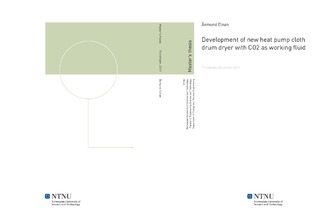| dc.contributor.advisor | Eikevik, Trygve Magne | nb_NO |
| dc.contributor.advisor | Rekstad, Inge Håvard | nb_NO |
| dc.contributor.author | Elnan, Åsmund | nb_NO |
| dc.date.accessioned | 2014-12-19T13:53:21Z | |
| dc.date.available | 2014-12-19T13:53:21Z | |
| dc.date.created | 2012-11-08 | nb_NO |
| dc.date.issued | 2011 | nb_NO |
| dc.identifier | 566042 | nb_NO |
| dc.identifier | ntnudaim:6881 | nb_NO |
| dc.identifier.uri | http://hdl.handle.net/11250/257294 | |
| dc.description.abstract | Since early the early 20th century the electrical tumble dryer became an appliance to dry clothes. During many years of improvements different configurations to solve issues on decreased drying time and more energy efficient solutions has been performed. Several different configurations have been developed; air vented dryers, condensing dryers and the most recent heat pump dryers. The heat pumps in drying technology became the next solution based on improved drying time and decreased energy consumption. With today’s focus on energy consumption, with energy demanding appliance such as the clothes dryer; new technology that satisfy the customers need must be available. By introducing the heat pump to the drying technology, a suitable refrigerant must be chosen. The choice should be based on several factors; the performance of the heat pump and the refrigerants GWP and ODP values, its toxicity and safety for the consumer. This report is based on a heat pump dryer made for an R134a system. R134a has a global warming potential (GWP) 1300 times the value of R744 (carbon dioxide). This report will present the feasibility of replacing the R134a system with a system designed for carbon dioxide as refrigerant. Carbon dioxide or R744 is a natural refrigerant, and it is in contrast to other commonly used refrigerants operating in the transcritical region. This implies that the heat rejection is performed with gliding temperature exchange, not by condensation as for the R134a. This is due to the low critical temperature of carbon dioxide; a critical pressure of 73.8 Bara and a critical temperature of 31.1˚C. Despite the required high pressures, the heat exchange properties of carbon dioxide in the critical region are very good, and new technology can take advantage of this. By SINTEF developed simulation tool HX SIM Basic 2007, based on results from the R134a cycle, heat exchangers have been designed to reach the optimal solution. The capacity of the heat changers and the compressor will be the same as the R134a system. The system is built with a manual throttling valve in parallel to a capillary tube, during the experiments the system will be tested to find the most optimal set point. Evaporating pressures from 40 to 50 Bara and gas cooler pressures from critical pressures to 120 Bara have been applied in the experiments. The main purpose of the experiments is to find a system design that will fulfil both energy saving requirements and have a simple enough construction for it to be a market product. Based on the experiments on this first prototype and the results obtained; a conclusion is that the dryer with CO2 as refrigerant is using marginally more energy than the R134a system. However this is a first prototype and its potential should be investigated further. | nb_NO |
| dc.language | eng | nb_NO |
| dc.publisher | Institutt for energi- og prosessteknikk | nb_NO |
| dc.subject | ntnudaim:6881 | no_NO |
| dc.subject | MTENERG energi og miljø | no_NO |
| dc.subject | Varme- og energiprosesser | no_NO |
| dc.title | Development of new heat pump cloth drum dryer with CO2 as working fluid | nb_NO |
| dc.type | Master thesis | nb_NO |
| dc.source.pagenumber | 181 | nb_NO |
| dc.contributor.department | Norges teknisk-naturvitenskapelige universitet, Fakultet for informasjonsteknologi, matematikk og elektroteknikk, Institutt for elkraftteknikk | nb_NO |

